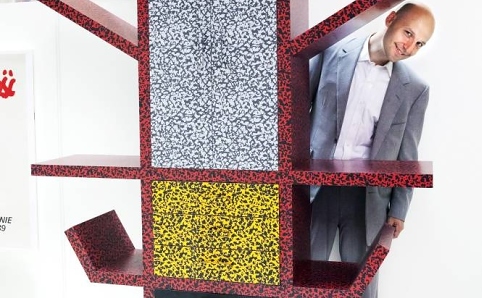LACMA Symposium / Living in a Modern Way
I was able to catch the last few presenters at LACMA's symposium,
I'm bummed I missed the rest.
Staci Steinberger from LACMA did a presentation on African-American designers and craftspeople
in Los Angeles, which included information on Tony Hill, John Smith and Doyle Lane (slide above).
The ads for Tony Hill's ceramics are all over Arts & Architecture magazine. It was good to get some information on him.
Individualism vs. Capitalism
Craft geek guru Glenn Adamson from the Victoria & Albert Museum ended the symposium
with a thought provoking presentation on California Design after 1965.
Adamson used this California Design 8 photo of a Sam Maloof executive chair, with
its back to
the camera in a tree grove, to illustrate the uncomfortable position of the individual
craftsman in a modern
capitalist society at mid-century. An underlying theme throughout the presentation was the notion
that mid-century modernism was a utopian scheme that ultimately failed. The way he talked bout this
photo kinda reminded me of Unhappy Hipster.
In his essay for LACMA's book, California Design, 1930-1965: "Living in a Modern Way", Adamson points
to several instances where the craftsman-designer was able to attain commercial success, most notably with
people like Edith Heath and Evelyn and Jerome Ackerman who used machinery to increase their craft production.
A quote in the essay that really makes that link between craft and capitalism evident is where housing
developer Joseph Eichler tells the Ackermans he'll be building enough homes that if they are able to sell a
pot to everyone who buys one, they should be OK.
Occupy P&K
Though not an Eichler, an Ackerman mosaic and Vista of California table are seen here in a San Diego
Palmer & Krisel development. This was no doubt a part of the sinister modern capitalist craft machine at work.
In his presentation, Adamson said something about mid-century California design was design for the few
since 99% of the population couldn't afford to live in a Richard Neutra house or buy expensive furniture.
That was no doubt true for a Neutra house with a Maloof chair, but the more pedestrian Palmer & Krisel
and Eichler homes outfitted with Vista of California furniture were undoubtedly much more accessible.
Craftsmanship in a Changing World exhibition in 1956
A craft revolt in the making?
Peter Voulkos was still making vases at this point.
Artist as Craftsman, Craftsman as Artist, 1963
Uh oh, with the rise of the designer-artist in the 60s comes the death of the designer-craftsman.
Voulkos, full on bronze, Artist as Craftsman, Craftsman as Artist exhibition
Along with Voulkos, Adamson uses J.B Blunk to show the shift away from craft-
commercialism to a more counterculture-art focus.
I wonder what J.B. is listening to on his iPod? Or is he texting?
Sacrilegious, I know. That guy was a bad ass.
Photo: jbblunk.com
J.B Blunk house, Inverness, CA
I had lunch up here some years ago. It was Point Reyes cheese on Blunk ceramics in the house he built by hand.
The place gave me chills. Amazing!
Photo: Cotter & Cole
The 1969 Objects:USA exhibit by New York art dealer Lee Nordness announced that the artist-craftsman
were officially accepted by the art world. With the craftsman out of the factory and into the art gallery,
I wonder what happened to the prices? 99% folks need not apply.
Failed Utopia = Memphis
With a slide of Peter Shire’s Bel Air chair as the symbol, Adamson suggested the
wackiness of postmodernism was the
rejection of modernism and the admittance of the failed utopia.
Personally, I think I'll stick with the failed modernist ideal of utopia, especially if the alternative is Memphis.
Photo: Kiss The Design
While a
slide of this 1979 Greiman image was up I tried to get a photo of the back of
Peter
Shire’s and April Greiman’s heads, who were sitting together in the audience,
but I chickened out.
Photo: Made in Space
The presentation ended with a contemporary art piece, a photograph of a sideways hippie weaving.
This was the emblem of dashed hope.
The presentation ended with a contemporary art piece, a photograph of a sideways hippie weaving.
This was the emblem of dashed hope.
I'm in the Glenn Adamson fan club.
Photo: Time Out













